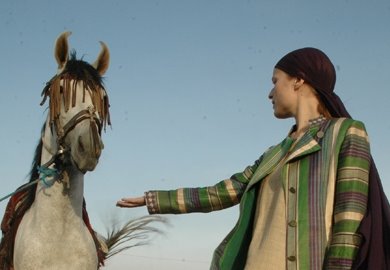The Setting
Kabul is a city of a unique breed: equal parts Middle Ages, Soviet Union, and post-apocalyptic science fiction.
On its streets, shepherds with biblical faces graze their goats on the plentiful garbage dumps; burqa-clad women float like ghosts through the sidewalk bazaars; and school-aged pedestrians skillfully navigate the stinking chaos of UN Landcruisers, buses, and donkey carts. Everywhere are the jagged-edge ruins of buildings--torn apart by explosions so that you can see the pink or green interior walls of what were once people's homes. There are telephone poles bent like drinking straws and bullet holes in the few surviving street signs. In Kabul, two decades of war make themselves known on every block, around every street corner.
From the comfortable distance afforded me by the car window, I observe it all on my daily commute to and from work. Between the walled compound where we live and the walled compound of the office are 45 minutes of what at first looked like complete misery and destruction.
After only a week in the city, however, I have realized that my first impression was flawed. Kabul is not on the verge of death. Despite the apparent destitution, the city is actually booming with energy and entrepreneurship. In the skeletons of old buildings there is a multitude of tiny shops and offices and lining some roads are old Russian storage containers that have been converted into grocery stores and bike dealerships. Every street, every sidewalk is a market, where people come to shop and to make a living. On one street it is all about tires, on the next, furniture. Few of Kabul's streets have names, but it is clear which one is Butcher Street and which one is Flower Street.
Every morning I see a man performing his beauty routine by the sidewalk water pump--brushing his teeth, soaping his face, shaving. How foolish of me to think that life stops in the absence of running water and electricity. Even in the most destitute of situations, people somehow carve out their livelihoods, they manage to celebrate weddings and funerals, and they find time to maintain friendships and social networks. Indeed, most of them appear to be living, not, as I had expected, merely surviving.
On its streets, shepherds with biblical faces graze their goats on the plentiful garbage dumps; burqa-clad women float like ghosts through the sidewalk bazaars; and school-aged pedestrians skillfully navigate the stinking chaos of UN Landcruisers, buses, and donkey carts. Everywhere are the jagged-edge ruins of buildings--torn apart by explosions so that you can see the pink or green interior walls of what were once people's homes. There are telephone poles bent like drinking straws and bullet holes in the few surviving street signs. In Kabul, two decades of war make themselves known on every block, around every street corner.
From the comfortable distance afforded me by the car window, I observe it all on my daily commute to and from work. Between the walled compound where we live and the walled compound of the office are 45 minutes of what at first looked like complete misery and destruction.
After only a week in the city, however, I have realized that my first impression was flawed. Kabul is not on the verge of death. Despite the apparent destitution, the city is actually booming with energy and entrepreneurship. In the skeletons of old buildings there is a multitude of tiny shops and offices and lining some roads are old Russian storage containers that have been converted into grocery stores and bike dealerships. Every street, every sidewalk is a market, where people come to shop and to make a living. On one street it is all about tires, on the next, furniture. Few of Kabul's streets have names, but it is clear which one is Butcher Street and which one is Flower Street.
Every morning I see a man performing his beauty routine by the sidewalk water pump--brushing his teeth, soaping his face, shaving. How foolish of me to think that life stops in the absence of running water and electricity. Even in the most destitute of situations, people somehow carve out their livelihoods, they manage to celebrate weddings and funerals, and they find time to maintain friendships and social networks. Indeed, most of them appear to be living, not, as I had expected, merely surviving.


0 Comments:
Post a Comment
<< Home